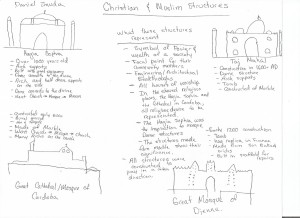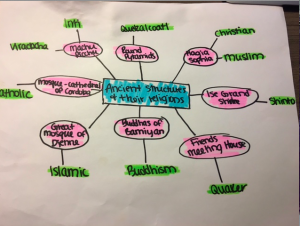My concept map was to differentiate the effect of religion between Japan’s shinto and the Aztecs. I included the gods that they each believed in, the various structures built, as well as how the religion affected their culture. I also made a few comparisons between the two, as each are very distance from each other, in both geography and timeline.
Concept Map
I decided to look at the religious structures. More specifically, I just looked at the religious structures mainly from the religions of Christianity and Islam. I analyzed the reading from class, watched the videos on the structures, and did additional research. On my concept map, I have each individual structure; Hagia Sophia, Great Cathedral of Cordoba, Taj Mahal, Great Mosque of Djenne. Under the structures I have some basic facts about them, when they were constructed, what they were made out of, what religion they were apart of, and the structure that they were made from. In the middle of my concept map, I have what these structures represent for their society. For each of the structures I analyzed, they represented and continue to represent wealth and power of their society. Some of these structures have been conquered by opposing religions because of their significance. I learned the Hagia Sophia was an inspiration to the Dome style of mosques, I also learned that the way that the buildings were designed was so that everyone could pray facing the same way. The architecture for the Hagia Sophia was a dome that came down on a square, it was an incredibly difficult structure to engineer. The Taj Mahal was built nearly the same way as the Hagia Sophia was. Many of these structures were built from marble, which signifies how important these structures were to the community.
Concept Map
In my concept map, I decided to look at the different religions practiced at the sacred structures we went over in class. I have read about each religion, but had not compared them all. In the case of ancient religions such as the Aztec and Incans, they practiced concepts more than particular religions; they worshipped many gods, believed in human sacrifice, and their sacred structures were built to recognize particular gods. Hagia Sophia was a Christian and Muslim place of worship at different times, and served the dual purpose of a cultural center. People at Ise Grand Shrine practice Shinto, and it is an extremely sacred structure. The Friends Meeting houses were “sacred” structures of the Quakers. Unlike the other grand structures, Quaker houses were very plain and simple. The Buddhas of Bamiyan statues held importance for people of the Buddhist religion, and were almost completely destroyed. The Great Mosque of Djenne is an Islamic center, and also serves as an important cultural center. Finally, the Mosque- Cathedral of Cordoba is a site of Catholic religion. In my comparison, I found that the majority of religious structures were very elaborate buildings. They exhibit some of the greatest architecture of the civilizations of the time, and many stand to this day because of it. Many of the structures also served as great community centers and places of learning aside from their religious purpose.
- « Previous Page
- 1
- …
- 46
- 47
- 48
- 49
- 50
- …
- 97
- Next Page »
